
Stephanoceras is an extinct genus of Stephanoceratoid ammonite which lived during the Bajocian. It is the type genus of the family Stephanoceratidae.

Xipheroceras is a Lower Jurassic ammonite belonging to the Eoderoceratidae, and sometimes placed in the subfamily Xipheroceratinae for which it is the namesake. It has been found in the upper Sinemurian of Europe and possibly Borneo.
Analytoceras is an extinct genus of cephalopod belonging to the Ammonite subclass that lived during the early Jurassic. Analytoceras, named by Alpheus Hyatt in 1900, is a lytoceratid and only member of the pleuroacanthitid subfamily Analytoceratinae, which has the same characters as its genus.

Aspidoceras is an extinct ammonoid cephalopod genus belonging to the family Aspidoceratidae.

Audaxlytoceras is an extinct genus of lytoceratid ammonites.
Balticeras is an involute, discoidal Upper Jurassic (Oxfordian) ammonite found in England, Germany, and Switzerland, belonging to the Perisphinctidae. The shell is strongly embracing, tending to be oxyconic. Sides are gently curved, converging on a narrow to sharp ventral rim.
Benacoceras is a strongly ribbed, evolute ammonite from the Late Jurassic, coiled so that all whorls are exposed. Ribbing is biplicate, with very short secondaries. The venter, the outer rim, is smooth, at least on the outer whorl.
Bradfordia is a moderately involute to involute genus included in the ammonoid cephalopod family Oppeliidae, coiled so that the outer whorl encloses most, or much, of the previous, but with a small umbilicus exposing inner whorls. The shell is compressed, whorl height much greater than width, extending well out from the contact with the adjacent inner whorl. Outer flanks are finely ribbed and the rounded venter is smooth.
Euaptetoceras is an evolute hildoceratoid ammonite from the lower Middle Jurassic, included in the family Hammatoceratidae and the subfamility Hammatoceratinae. The genus may be a junior synonym for Eudmetoceras of Buckman, 1920.
Oecoptychius is an extinct genus of fossil ammonite cephalopods. The species lived during the Middle Jurassic.

Hildoceras is a genus of ammonite from the Jurassic period in the family Hildoceratidae. The shells are characterized by a narrow discoidal evolute shape, keeled venter, concave ribs along the outer flanks, and a shallow spiral groove running along smooth inner flanks. Whorls slightly overlap, cross sections are compressed. The ventral keel is bordered on either side by a shallow groove. The genus was named by Alpheus Hyatt after Saint Hilda in 1876.

Peltoceras is an extinct ammonite genus from the aspidoceratid subfamily Peltoceratinae that lived during the later part of the Middle Jurassic.
Eoderoceras is an evolute, round whorled ammonite from the Lower Jurassic with an outer row of distinct spines, and in some, an inner row of tubercles, on either side; ribs only on the inner whorls.
Crucilobiceras is an ammonoid cephalopod genus from the Lower Jurassic belonging to the eoderoceratoidean family Eoderoceratidae. Cruciliboceras has an evolute shell, such that all whorls are well exposed, with persistent radial ribbing and with spines or tubercles on the outer, ventral, rim, and in some, tubercles in the inner, umbilical, rim. The genus Crucilobiceras is commonly found along the Jurassic Coast of England.

Kepplerites is a moderately evolute ammonite from the lower Callovian included in the Stephanoceratoidea.
Ptycholytoceras is a genus of fast-moving nektonic ammonoid carnivores included in the Lytoceratinae in which the shell has round inner and depressed outer whorls and sides with dorso-ventrally sloping folds that do not pass onto the venter.
Hemilytoceras is a lytoceratin ammonite genus with round inner whorls, outer whorls becoming depressed and in some developing high lamellae (ribs) that bend forward over the venter. The type species H. immanae came from the Tithonian of Europe. The genus is known from the overall Upper Jurassic of central and southern Europe, North Africa, and western India.
Melchiorites is a desmoceratid ammonite genus included in the subfamily Puzosiinae. Member species are characterized by an essentially evolute shell in which the early whorls are smooth, with sinuous radial or oblique constrictions but in which later whorls have feeble intermediate ribs on the outer part of the sides and venter.
Dayiceras is a finely ribbed polymorphitid eoderoceratacean ammonoid cephalopod from the Jurassic, named by Spath in 1920. The shell is evolute, coiled such that all whorls are exposed. The whorl section is compressed such as to be higher than wide. A row of fine tubercles runs along the middle of the outer rim, the venter.

Hammatoceras is a genus of ammonites belonging to the family Hammatoceratidae which lived during the Toarcian stage of the Early/Lower Jurassic between about 184 and 175 million year ago.







